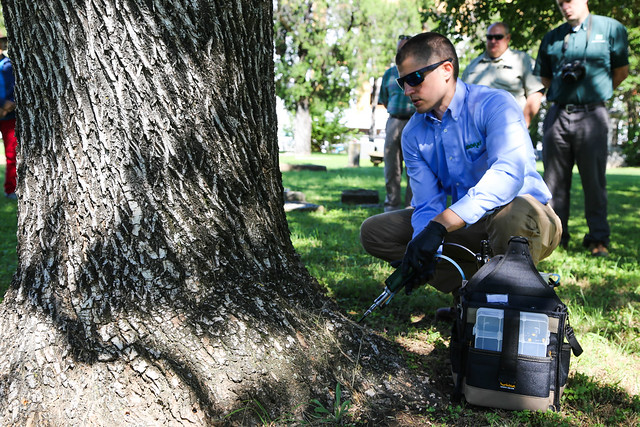The Emerald Ash Borer recently reared its ugly head in Ft. Worth, TX.
The Texas Forest Service has prepared for this moment for several years, knowing it would only be a matter of time until EAB would be found. The story of how it was found is unique…. In April of 2017, a 10 year old nature enthusiast posted a picture of a metallic green beetle he’d found in his backyard to iNaturalist.org. He was asking for help to identify this interesting beetle. It wasn’t until the following summer that another member of iNaturalist correctly identified the insect as EAB! The TFS was notified immediately and a group of foresters and entomologists began scouring the woods near where the first beetle was found. In the fall of 2018, larvae were pulled from a symptomatic ash tree and sent to the USDA for a positive ID. The initial find is on the south side of Eagle Mountain Lake, near the Ft. Worth Nature Center. 2019 trapping efforts have found LOTS of EAB in that area. According to Allen Smith, Forest Health Coordinator, EAB has likely been in the area for 8-10 years. Trees within 15 miles of the known EAB find should be treated. This represents 706 square miles and an estimated 1.5 million ash trees!

Arborjet’s South Central Technical Manager, Emmett Muennink, recently teamed up with TFS and the City of Fort Worth to treat a pair of regional champion trees. A regional champion is the largest tree of their respective species within a twenty-five county area. The treatment events were used as educational opportunities for forestry staff, municipal and commercial arborists. The regional champion Green Ash is located inside the Ft. Worth Nature Center, about two miles from the initial find and near EAB traps that have yielded high catch rates. This 55-inch diameter Green Ash is the second largest in the state and may be one of the few ash trees in the Nature Center that is preserved. The regional champion Texas Ash tree is 26 inches in diameter and located in Pioneer’s Rest Cemetery in Ft. Worth. This historical cemetery has occupants dating back to the early settlement of the Ft. Worth area!
 Emmett demonstrated how to inject trees using the Arborjet QUIK-jet AIR® and TREE-äge G4 ®. He was also able to lend practical advice about EAB management strategies drawing on his experience working with communities in Kansas and Missouri. The two trees will continue to be monitored and retreated at 2-3 year intervals at no cost to the city. The city of Ft. Worth estimates that 4-5% of their urban tree canopy is Ash species. While this is a smaller percentage of ash compared to some mid-western cities, it is a significant number of trees. Ft. Worth is currently gathering data on their Ash trees and developing a management strategy.
Emmett demonstrated how to inject trees using the Arborjet QUIK-jet AIR® and TREE-äge G4 ®. He was also able to lend practical advice about EAB management strategies drawing on his experience working with communities in Kansas and Missouri. The two trees will continue to be monitored and retreated at 2-3 year intervals at no cost to the city. The city of Ft. Worth estimates that 4-5% of their urban tree canopy is Ash species. While this is a smaller percentage of ash compared to some mid-western cities, it is a significant number of trees. Ft. Worth is currently gathering data on their Ash trees and developing a management strategy.
Arborjet’s Saving America’s Iconic Trees initiative is helping to preserve historic and valuable trees all over the United States. If you know of a candidate tree, please fill out the nomination form.
Press Release: Forth Worth Braces Regional Champion Trees for Tree-Killing Pest
News/Media: Fort Worth Braces Regional Champion Trees for Tree-Killing Pest
